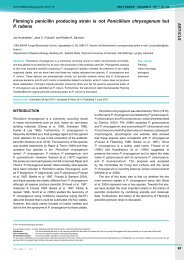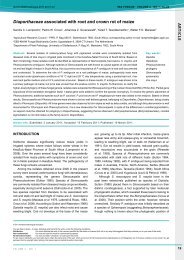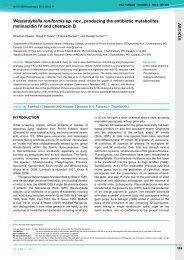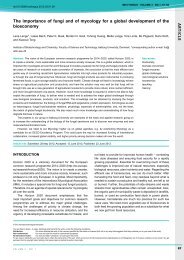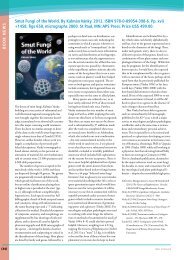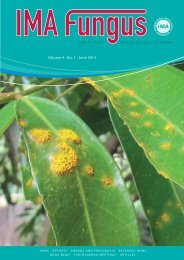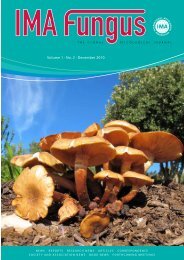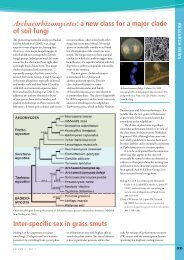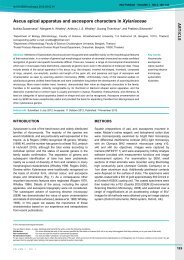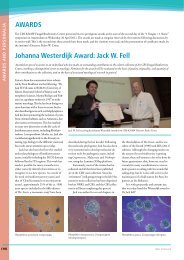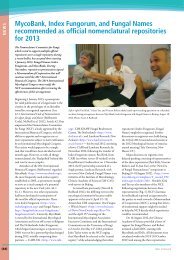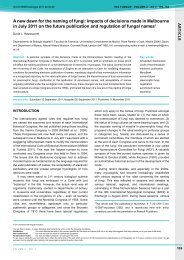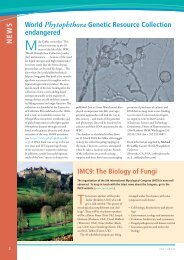Complete issue - IMA Fungus
Complete issue - IMA Fungus
Complete issue - IMA Fungus
Create successful ePaper yourself
Turn your PDF publications into a flip-book with our unique Google optimized e-Paper software.
Novel species of Aspergillus sect. Nigri<br />
ARTICLE<br />
A<br />
B<br />
C<br />
F<br />
F<br />
D<br />
E<br />
G<br />
Fig. 6. Aspergillus trinidadensis (ITEM 14821 T ) culture plates are 9 cm diam, colonies grown at 25 °C for 7 d. A. CYA colonies. B. MEA colonies.<br />
C. CREA colonies. D–E. Smooth stipes, globose to subglobose vesicle, and conidia. F. Globose to ellipsoidal, conidia, with echinulate surface.<br />
G. Monophialides and conidia. Bars = 10 µm.<br />
produced growth 4–21 mm and from no growth to 7 mm<br />
diam, respectively.<br />
Stipes (Fig. 6d–e) smooth or occasionally with a limited<br />
surface granulation just below the vesicle, hyaline or<br />
occasionally pigmented just below the vesicle, long if from<br />
substrate, short with small vesicles if borne from aerial<br />
hyphae (50–)150–800(–1800) × (5–)8–14(18) µm, vesicles<br />
globose to subglobose occasionally ellipsoidal (10–)30–70(–<br />
100) µm diam, conidial heads uniseriate, phialides (5-)7–9(–<br />
12) × (3–)3.5–4.5(–6) µm commonly covering entire vesicle,<br />
occasionally producing monophialides (Fig. 6g) 3–42 × 3.5–8<br />
µm, conidia (Fig. 6f) globose to ellipsoidal, rarely pyriform,<br />
4–7(–8) × 3.5–7 µm, if borne from monophialides up to 13 ×<br />
10 µm, with finely spiny to echinulate surface. No ochratoxin<br />
A produced.<br />
DISCUSSION<br />
In our studies of the indoor environment the dominant species<br />
of uniseriate Aspergillus section Nigri were A. violaceofuscus<br />
(syn. A. japonicus) (30 of 55 isolates) and A.brunneoviolaceus<br />
(syn. A. fijiensis) (18 of 55 isolates). Aspergillus violaceofuscus<br />
was isolated from 15 states in the USA, mainly from Southern<br />
and Mid-Atlantic states (Table 1). Aspergillus violaceofuscus<br />
(syn. A. japonicas) and A. aculeatus have previously only<br />
been found in the tropics (Nielsen et al. 2009). Nine isolates<br />
(ITEM 14800, 14803, 14805, 14810, 14827, 14828, 14830,<br />
14834, and14837) of the 30 A. violaceofuscus isolates<br />
produced sclerotia on CYA or OA, buff to yellowish-orange<br />
or orange-brown, subspherical to elongate, 300–1000 µm<br />
long. Also, three isolates (ITEM 14794, ITEM 14799, and<br />
ITEM 14802) of A. brunneoviolaceus produced abundant<br />
buff to orange-brown sclerotia, 250–800 µm long. None of<br />
the three sclerotium producing A. brunneoviolaceus isolates<br />
produced ochratoxin A. Aspergillus brunneoviolaceus<br />
isolates commonly have good to very good acid production.<br />
However, two isolates ITEM 14806 and ITEM 14831, did not<br />
show acid reactions on CREA agar, nor were they sulcate<br />
on CYA. Aspergillus brunneoviolaceus (syn. A. fijiensis) was<br />
previously isolated from soil, Fiji (CBS 313.89), Lactuca<br />
sativa, Indonesia (CBS 119.49) (Varga et al. 2011), guano,<br />
Peru (IHEM 18675), corneal scraping keratitis, India (IHEM<br />
22812), droppings of Coenobita sp., Bahamas (IHEM 4062)<br />
(Hendricks at al. 2011), and industrial material, China (CCF<br />
108) (Hubka & Kolarik 2012). This is the first report of A.<br />
volume 3 · no. 2<br />
171



